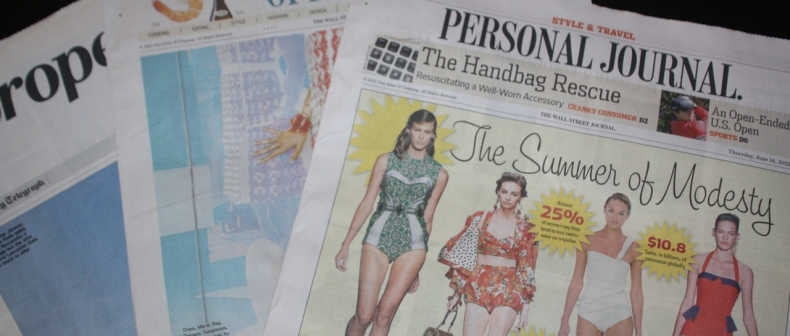
Image by Michael Kolberg
Newspapers and magazines want to make money and they don’t know how. They’re told, and they must know, that the web is the way to go, but advertisers are not paying for web advertising what they used to and sometimes still are paying for print. So they’re in a bind.
As a result, the people who make the money for these companies, the marketing folks, the ad sales people, the publishers, are taking on ever more influential roles, becoming potential saviors instead of the necessary evils they once were. And as they do, there is increasing talk of blurring the line between advertising and editorial.
Magazines have something companies want: their readers’ attention and trust. Nobody wins if they lose that, but in order to maintain it, editors and their publishers have to hold that line, no matter how smudged it gets.
We’re told this church and state division was never as solid as it seemed, but we’re told this by the likes of Tyler Brulé, whose experiments in honorably attempting to bring the editorial and money-making aspects of the Monocle closer together is one of the new models people are looking at for the future of the business. And we’ve got to be careful of people like him, and arguments like his, because this desire to throw off the shackles of editorial independence has always been there, just beneath the surface, always looking for cracks to seep up into a cultural conversation that’s already diluted by governments convinced to look at corporations as people and marketing budgets as addenda to their own funding efforts.
The next five or 10 years will likely see the introduction and crystallization of new ways of producing, disseminating and consuming news and views, and it’s important, as we lay down these new foundations, that corporations looking for new ways to sell us things are not allowed to turn journalists into spokesmodels.
This is not to say that companies won’t play new and maybe even bigger roles in this evolving industry. What it does mean, though, is that we should not allow the rest of the biz to go the way of health and beauty journalism.
Vigilance is especially important just now, as the Globe announces the assimilation of its Arts section into its Life section, that the former not take its new lead from the latter.
There are all kinds of journalism that are increasingly being seen as inessential, fluffy, journalism we have no serious expectations from. Sections about cars and real estate and travel are increasingly being seen, both by the newspapers that run them and the people who read them, as already essentially compromised by their advertisers. True, they do tend to be nice little moneymakers, and they do, like all such media entities, rely on their advertisers, but there’s no reason to hand over the keys to the shop. Advertisers need the readers of these sections just as much as the sections need the advertisers, and the desperation pervading the industry is no reason to hand over any more power. Cars are a huge part of our lives, as is real estate, as is travel. These are important things, the three things, in fact — not uncoincidentally — that we spend our largest chunks of money on. We should be able to take the journalism about those things seriously, and not just assume that the sections exist only because there are advertisers to fill the pages.
The same goes for health and beauty, which make up a large part of life sections and the lion’s share of women’s magazines. Except, it seems, they may already be further along the path we don’t want to go down, an example already of what must not happen.
The most recent issue of the Ryerson Review of Journalism has a story towards the back of the book about the health and beauty end of the business. In typical RRJ fashion — these stories are mostly written by journalism students, who may work on them for months — it’s thorough, well researched, it’s got good quotes, and it’s a little callow.
For instance, it seems to take at face value interviewees’ protestations that they are not, in fact, in their advertisers’ back pockets. Talking to longtime journalist Ceri Marsh, Stephanie Fereiro characterizes her as thinking “that advertisers have every right to feel they should be covered. ‘They’ve got products coming out; they’ve got stories to tell,’ she says. ‘The readers of a fashion magazine want to know that —- they want to know what’s new. In a lot of ways, it’s as it should be.’”
She’s right: advertisers interests do often overlap with readers’. People like to buy things, and they like to know about what’s on the market before they do. But companies do not have stories to tell. They have products to sell. The distinction is of the gravest importance. People tell stories, journalists tell stories; the only stories companies have to tell are the ones written for them by people they employ to do it. These people are marketers, publicists and ad agencies; they should not be journalists. The stories journalists tell, whether they’re about eye shadow or agricultural policy, should be their stories, not advertisers’ or other lobbyists.
“In the fashion and beauty realm,” Fereiro writes, referring once again to a consensus she’s reached with her interview subjects, “knowing who your advertisers are and working to live up to their expectations are just part of the territory.” Advertisers do of course have expectations, and they must of course be met, or they will take their business elsewhere. But those expectations should not, cannot be editorial and writers and editors should not, cannot be allowing them to develop. Advertisers have reasonable expectations about demographics, circulation, time spent on a page and in the age of click-throughs, even instant conversion rates. But uncritical portrayal of products, telling their “stories”, is what ads are for, not articles. Blurry lines are still lines. Critical writing, properly done, gives readers enough information to form their own opinions about the subject at hand, whether the writers say nice things about them or not.
I don’t know why editors buckle like this. Market pressure, they might say. You do what you’ve got to do. I wonder, though, if as a breed journalists, may have had greater than average experience being bullied in schoolyards. If advertisers didn’t need magazines, they wouldn’t buy ads in them. But they do buy ads in them. It’s in corporate nature to push, to get as much as they can for as little as they’re able. It’s everyone else’s job to push back.
But reading this piece in the RRJ, I get the sense that for these folks, the reason the line’s so blurry is that they’ve moved so far past it they can barely see it anymore. Listen to another health and beauty editor, Laura Fraioli-Keough, talking about “exclusives”, stories that companies demand ignore every product except theirs:
“You can try to push me in directions that you want me to go in but at the end of the day, my creativity is going to find a way out of those boxes. I had to engineer a way to make a story that was credible and relatable, and that would make sense to the reader I was speaking to. I just think there’s a way to report even within the confines of an exclusive. I was told lots of times, ‘We want you to write a story about this product and these are the only pictures you can use,’ and it was my job to make that page and that story relatable and make sense to the reader I was talking to. I pushed back, and you have the ability to do that.”
That’s not an editor talking, that’s a poorly paid ad exec.
To be clear, Brulé is right about one thing: there never was a golden age, when writers wrote, editors edited and publishers published without a care in the world about advertisers. But that’s no reason to resign ourselves to the sort of hopeless darkness Marsh and Fraioli-Keough are presaging.
____
Bert Archer writes for Toronto Standard. Follow him on Twitter: @bertarcher.
For more, follow us on Twitter: @TorontoStandard, or subscribe to our newsletter.














